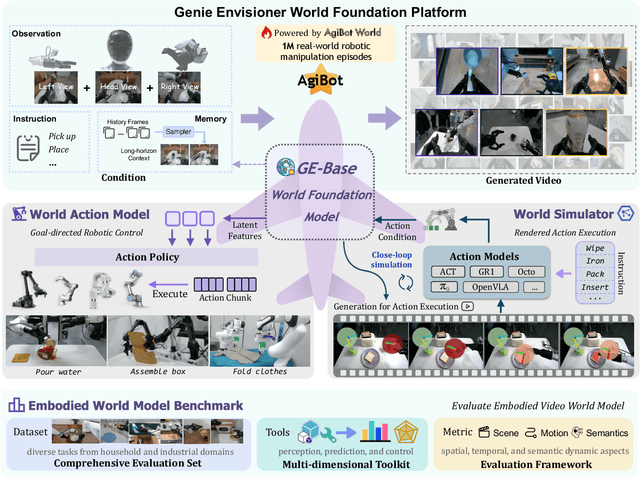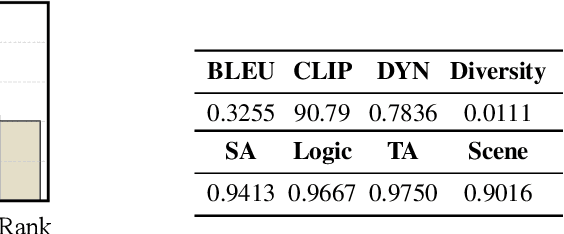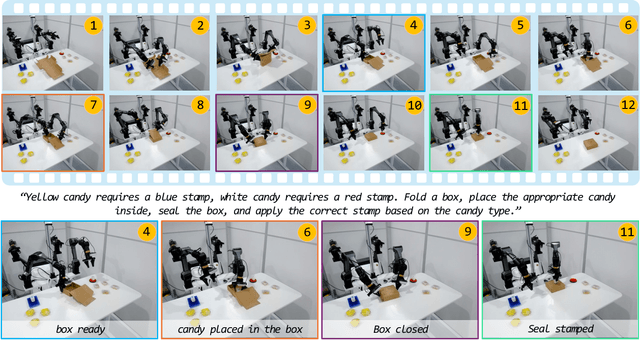Yue Hu
Artificial Intelligence Lab, Department of Computer Systems Engineering, University of Engineering and Applied Sciences
NegoCollab: A Common Representation Negotiation Approach for Heterogeneous Collaborative Perception
Oct 31, 2025Abstract:Collaborative perception improves task performance by expanding the perception range through information sharing among agents. . Immutable heterogeneity poses a significant challenge in collaborative perception, as participating agents may employ different and fixed perception models. This leads to domain gaps in the intermediate features shared among agents, consequently degrading collaborative performance. Aligning the features of all agents to a common representation can eliminate domain gaps with low training cost. However, in existing methods, the common representation is designated as the representation of a specific agent, making it difficult for agents with significant domain discrepancies from this specific agent to achieve proper alignment. This paper proposes NegoCollab, a heterogeneous collaboration method based on the negotiated common representation. It introduces a negotiator during training to derive the common representation from the local representations of each modality's agent, effectively reducing the inherent domain gap with the various local representations. In NegoCollab, the mutual transformation of features between the local representation space and the common representation space is achieved by a pair of sender and receiver. To better align local representations to the common representation containing multimodal information, we introduce structural alignment loss and pragmatic alignment loss in addition to the distribution alignment loss to supervise the training. This enables the knowledge in the common representation to be fully distilled into the sender.
Rate-Distortion Optimized Communication for Collaborative Perception
Sep 26, 2025



Abstract:Collaborative perception emphasizes enhancing environmental understanding by enabling multiple agents to share visual information with limited bandwidth resources. While prior work has explored the empirical trade-off between task performance and communication volume, a significant gap remains in the theoretical foundation. To fill this gap, we draw on information theory and introduce a pragmatic rate-distortion theory for multi-agent collaboration, specifically formulated to analyze performance-communication trade-off in goal-oriented multi-agent systems. This theory concretizes two key conditions for designing optimal communication strategies: supplying pragmatically relevant information and transmitting redundancy-less messages. Guided by these two conditions, we propose RDcomm, a communication-efficient collaborative perception framework that introduces two key innovations: i) task entropy discrete coding, which assigns features with task-relevant codeword-lengths to maximize the efficiency in supplying pragmatic information; ii) mutual-information-driven message selection, which utilizes mutual information neural estimation to approach the optimal redundancy-less condition. Experiments on 3D object detection and BEV segmentation demonstrate that RDcomm achieves state-of-the-art accuracy on DAIR-V2X and OPV2V, while reducing communication volume by up to 108 times. The code will be released.
pyFAST: A Modular PyTorch Framework for Time Series Modeling with Multi-source and Sparse Data
Aug 26, 2025Abstract:Modern time series analysis demands frameworks that are flexible, efficient, and extensible. However, many existing Python libraries exhibit limitations in modularity and in their native support for irregular, multi-source, or sparse data. We introduce pyFAST, a research-oriented PyTorch framework that explicitly decouples data processing from model computation, fostering a cleaner separation of concerns and facilitating rapid experimentation. Its data engine is engineered for complex scenarios, supporting multi-source loading, protein sequence handling, efficient sequence- and patch-level padding, dynamic normalization, and mask-based modeling for both imputation and forecasting. pyFAST integrates LLM-inspired architectures for the alignment-free fusion of sparse data sources and offers native sparse metrics, specialized loss functions, and flexible exogenous data fusion. Training utilities include batch-based streaming aggregation for evaluation and device synergy to maximize computational efficiency. A comprehensive suite of classical and deep learning models (Linears, CNNs, RNNs, Transformers, and GNNs) is provided within a modular architecture that encourages extension. Released under the MIT license at GitHub, pyFAST provides a compact yet powerful platform for advancing time series research and applications.
IDU: Incremental Dynamic Update of Existing 3D Virtual Environments with New Imagery Data
Aug 25, 2025Abstract:For simulation and training purposes, military organizations have made substantial investments in developing high-resolution 3D virtual environments through extensive imaging and 3D scanning. However, the dynamic nature of battlefield conditions-where objects may appear or vanish over time-makes frequent full-scale updates both time-consuming and costly. In response, we introduce the Incremental Dynamic Update (IDU) pipeline, which efficiently updates existing 3D reconstructions, such as 3D Gaussian Splatting (3DGS), with only a small set of newly acquired images. Our approach starts with camera pose estimation to align new images with the existing 3D model, followed by change detection to pinpoint modifications in the scene. A 3D generative AI model is then used to create high-quality 3D assets of the new elements, which are seamlessly integrated into the existing 3D model. The IDU pipeline incorporates human guidance to ensure high accuracy in object identification and placement, with each update focusing on a single new object at a time. Experimental results confirm that our proposed IDU pipeline significantly reduces update time and labor, offering a cost-effective and targeted solution for maintaining up-to-date 3D models in rapidly evolving military scenarios.
Communication-Efficient Multi-Agent 3D Detection via Hybrid Collaboration
Aug 09, 2025Abstract:Collaborative 3D detection can substantially boost detection performance by allowing agents to exchange complementary information. It inherently results in a fundamental trade-off between detection performance and communication bandwidth. To tackle this bottleneck issue, we propose a novel hybrid collaboration that adaptively integrates two types of communication messages: perceptual outputs, which are compact, and raw observations, which offer richer information. This approach focuses on two key aspects: i) integrating complementary information from two message types and ii) prioritizing the most critical data within each type. By adaptively selecting the most critical set of messages, it ensures optimal perceptual information and adaptability, effectively meeting the demands of diverse communication scenarios.Building on this hybrid collaboration, we present \texttt{HyComm}, a communication-efficient LiDAR-based collaborative 3D detection system. \texttt{HyComm} boasts two main benefits: i) it facilitates adaptable compression rates for messages, addressing various communication requirements, and ii) it uses standardized data formats for messages. This ensures they are independent of specific detection models, fostering adaptability across different agent configurations. To evaluate HyComm, we conduct experiments on both real-world and simulation datasets: DAIR-V2X and OPV2V. HyComm consistently outperforms previous methods and achieves a superior performance-bandwidth trade-off regardless of whether agents use the same or varied detection models. It achieves a lower communication volume of more than 2,006$\times$ and still outperforms Where2comm on DAIR-V2X in terms of AP50. The related code will be released.
Imaginative World Modeling with Scene Graphs for Embodied Agent Navigation
Aug 09, 2025Abstract:Semantic navigation requires an agent to navigate toward a specified target in an unseen environment. Employing an imaginative navigation strategy that predicts future scenes before taking action, can empower the agent to find target faster. Inspired by this idea, we propose SGImagineNav, a novel imaginative navigation framework that leverages symbolic world modeling to proactively build a global environmental representation. SGImagineNav maintains an evolving hierarchical scene graphs and uses large language models to predict and explore unseen parts of the environment. While existing methods solely relying on past observations, this imaginative scene graph provides richer semantic context, enabling the agent to proactively estimate target locations. Building upon this, SGImagineNav adopts an adaptive navigation strategy that exploits semantic shortcuts when promising and explores unknown areas otherwise to gather additional context. This strategy continuously expands the known environment and accumulates valuable semantic contexts, ultimately guiding the agent toward the target. SGImagineNav is evaluated in both real-world scenarios and simulation benchmarks. SGImagineNav consistently outperforms previous methods, improving success rate to 65.4 and 66.8 on HM3D and HSSD, and demonstrating cross-floor and cross-room navigation in real-world environments, underscoring its effectiveness and generalizability.
From Canada to Japan: How 10,000 km Affect User Perception in Robot Teleoperation
Aug 07, 2025Abstract:Robot teleoperation (RTo) has emerged as a viable alternative to local control, particularly when human intervention is still necessary. This research aims to study the distance effect on user perception in RTo, exploring the potential of teleoperated robots for older adult care. We propose an evaluation of non-expert users' perception of long-distance RTo, examining how their perception changes before and after interaction, as well as comparing it to that of locally operated robots. We have designed a specific protocol consisting of multiple questionnaires, along with a dedicated software architecture using the Robotics Operating System (ROS) and Unity. The results revealed no statistically significant differences between the local and remote robot conditions, suggesting that robots may be a viable alternative to traditional local control.
Genie Envisioner: A Unified World Foundation Platform for Robotic Manipulation
Aug 07, 2025



Abstract:We introduce Genie Envisioner (GE), a unified world foundation platform for robotic manipulation that integrates policy learning, evaluation, and simulation within a single video-generative framework. At its core, GE-Base is a large-scale, instruction-conditioned video diffusion model that captures the spatial, temporal, and semantic dynamics of real-world robotic interactions in a structured latent space. Built upon this foundation, GE-Act maps latent representations to executable action trajectories through a lightweight, flow-matching decoder, enabling precise and generalizable policy inference across diverse embodiments with minimal supervision. To support scalable evaluation and training, GE-Sim serves as an action-conditioned neural simulator, producing high-fidelity rollouts for closed-loop policy development. The platform is further equipped with EWMBench, a standardized benchmark suite measuring visual fidelity, physical consistency, and instruction-action alignment. Together, these components establish Genie Envisioner as a scalable and practical foundation for instruction-driven, general-purpose embodied intelligence. All code, models, and benchmarks will be released publicly.
What You Perceive Is What You Conceive: A Cognition-Inspired Framework for Open Vocabulary Image Segmentation
May 26, 2025



Abstract:Open vocabulary image segmentation tackles the challenge of recognizing dynamically adjustable, predefined novel categories at inference time by leveraging vision-language alignment. However, existing paradigms typically perform class-agnostic region segmentation followed by category matching, which deviates from the human visual system's process of recognizing objects based on semantic concepts, leading to poor alignment between region segmentation and target concepts. To bridge this gap, we propose a novel Cognition-Inspired Framework for open vocabulary image segmentation that emulates the human visual recognition process: first forming a conceptual understanding of an object, then perceiving its spatial extent. The framework consists of three core components: (1) A Generative Vision-Language Model (G-VLM) that mimics human cognition by generating object concepts to provide semantic guidance for region segmentation. (2) A Concept-Aware Visual Enhancer Module that fuses textual concept features with global visual representations, enabling adaptive visual perception based on target concepts. (3) A Cognition-Inspired Decoder that integrates local instance features with G-VLM-provided semantic cues, allowing selective classification over a subset of relevant categories. Extensive experiments demonstrate that our framework achieves significant improvements, reaching $27.2$ PQ, $17.0$ mAP, and $35.3$ mIoU on A-150. It further attains $56.2$, $28.2$, $15.4$, $59.2$, $18.7$, and $95.8$ mIoU on Cityscapes, Mapillary Vistas, A-847, PC-59, PC-459, and PAS-20, respectively. In addition, our framework supports vocabulary-free segmentation, offering enhanced flexibility in recognizing unseen categories. Code will be public.
SWE-Dev: Evaluating and Training Autonomous Feature-Driven Software Development
May 22, 2025Abstract:Large Language Models (LLMs) have shown strong capability in diverse software engineering tasks, e.g. code completion, bug fixing, and document generation. However, feature-driven development (FDD), a highly prevalent real-world task that involves developing new functionalities for large, existing codebases, remains underexplored. We therefore introduce SWE-Dev, the first large-scale dataset (with 14,000 training and 500 test samples) designed to evaluate and train autonomous coding systems on real-world feature development tasks. To ensure verifiable and diverse training, SWE-Dev uniquely provides all instances with a runnable environment and its developer-authored executable unit tests. This collection not only provides high-quality data for Supervised Fine-Tuning (SFT), but also enables Reinforcement Learning (RL) by delivering accurate reward signals from executable unit tests. Our extensive evaluations on SWE-Dev, covering 17 chatbot LLMs, 10 reasoning models, and 10 Multi-Agent Systems (MAS), reveal that FDD is a profoundly challenging frontier for current AI (e.g., Claude-3.7-Sonnet achieves only 22.45\% Pass@3 on the hard test split). Crucially, we demonstrate that SWE-Dev serves as an effective platform for model improvement: fine-tuning on training set enabled a 7B model comparable to GPT-4o on \textit{hard} split, underscoring the value of its high-quality training data. Code is available here \href{https://github.com/justLittleWhite/SWE-Dev}{https://github.com/justLittleWhite/SWE-Dev}.
 Add to Chrome
Add to Chrome Add to Firefox
Add to Firefox Add to Edge
Add to Edge